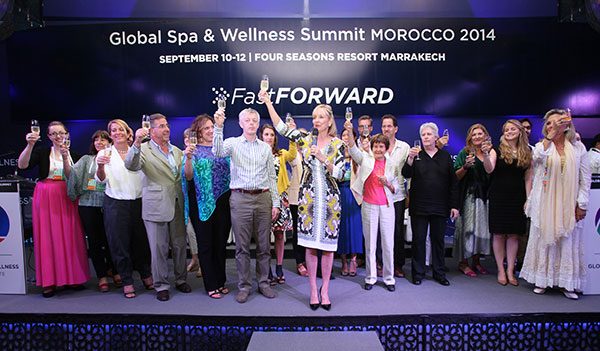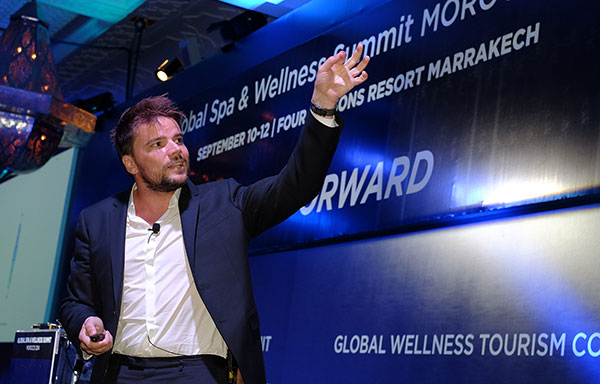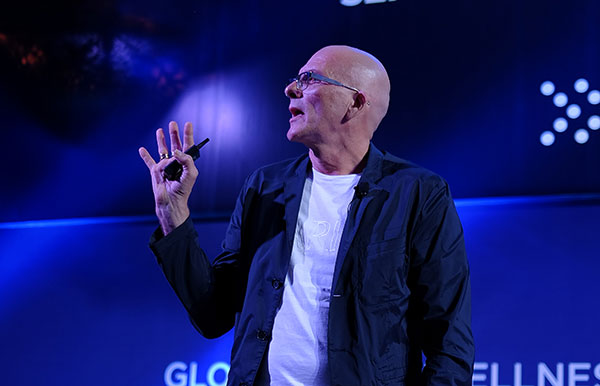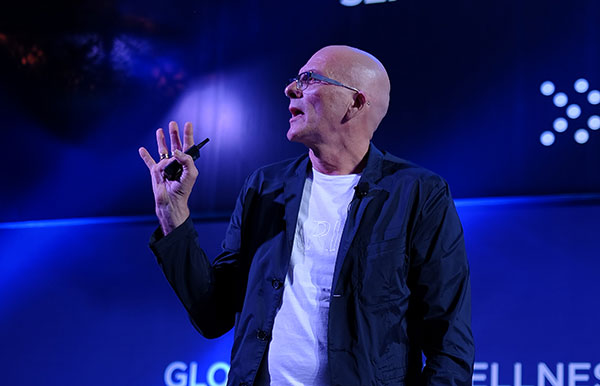This year’s Global Spa & Wellness Summit, held in Marrakech, September 10-12, proved to once again to be a hub for the latest reporting on the state of the spa and wellness industry from researchers and analysts around the world. As dry as toast as that may sound, understanding the industry we are a part of is essential to exceeding within it. Here are a few of the highlights, and look for more in the next issue of the magazine as well as future enewsletters – there’s lots to digest!
The conference’s future-looking agenda tackled topics including architecture and design’s influence on experience and sustainability, the seismic generational and gender shift, the impact of technology on human interaction, Africa’s role in wellness and more. ‘This year’s GSWS agenda included futurists, marketing gurus, and, of course, spa and wellness experts,’ said Susie Ellis, chairman and CEO of the GSWS. ‘The journey we took together into our future was full of game changers, and we’ve identified ten major shifts that will impact how we will approach wellness in the future.
Please read on for the top 10 takeaways from the summit:

ABOVE: Global Spa and Wellness Summit CEO and chair Susie Ellis leads the toast to the 2014 event.
1. Architecture and Design Reboot
For decades, the spa industry has relied on Asian influences to guide not only spa menus but also the look and feel of its facilities. Dutch architecture maverick Bjarke Ingels told delegates: ‘You not only have the ability, you have the responsibility to change the spaces we live in.’ His envelope-pushing designs promise to inspire a complete re-think in how to approach spa architecture and, importantly, create sustainable designs that increase, rather than decrease enjoyment.

ABOVE: Bjarke Ingels, Architect, Founding Partner, Bjarke Ingels Group, Denmark.
2. Authenticity in Overdrive
Authenticity, the seeking of local, indigenous experiences, has long been a rallying cry in spa and wellness treatments but mass urbanisation and the rise of the Millennials have ratcheted up an insistence for ‘can’t get anywhere else’ experiences. ‘Increasingly, it’s not the destination that matters, it’s the experience,’ said Peter Greenberg, CBS travel editor. ‘Generic luxury no longer satisfies most of us; there is a growing desire to find the heartbeat of a place and culture and then share it with the rest of the world on social networks.’ Greenberg noted that this social, ‘experience one-upmanship’ creates a buzz that traditional marketing can’t and, ultimately, the experience itself markets the destination.
3. Outsmarting Your Genes: Personalised Preventative Medicine
‘Predictive, personalised, preventative healthcare will transform the landscape of healthcare over the next decade,’ said Dr. Nasim Ashraf of DNA Health Corp. ‘Epigenetic testing is essentially the science of outsmarting your genes.’ Dr. Ashraf pointed out that much of our wellbeing is not destiny and can be influenced by environment. And as personalised genetic testing continues to get not only more sophisticated but also more affordable, it’s possible to know what chronic diseases and conditions (cancer, heart disease, Alzheimer’s, obesity, etc.) individuals are prone to and then prescribe not only the right treatments, but, importantly, the lifestyle changes that can prevent their expression. Epigenetic testing is already being performed at medical and destination spas around the world.
4. Generational and Gender Shift to Youth and Women
Spa and wellness marketers need to cast a wider net by focusing more on emerging generations – Millennials and generation Z (for want of a better term) – that are different to the ageing, time-rich Baby Boomers most wellness marketers have focused on to date. (For example, generation Z is the first to have never lived without the influences of social media and technology.) A massive demographic shift from male to female is also occurring. Due in part to their longer lives, and increasing wealth and education (70 percent of students in universities today are women), women will grow rapidly in influence. ‘The population of women in cities is massively on the rise and wealth is being transferred from men to women,’ Kjell Nordstrom, the Swedish economist and co-author of Funky Business, told delegates.

ABOVE: Kjell Nordstro”?m
5. Urbanisation to Supersede Suburbanisation
The future will have a marked move away from suburbanisation to urbanisation, and in 2030, 80 percent of all people will live in urban settings. Nordstrom told delegates that the perception of the world as 200 countries will quickly shift to one of 600 cities, and, in a world ruled by cities, inhabitants will crave nature and simplicity but also extreme fitness, beauty and wellness.
6. The Loneliness Epidemic
‘We used to die of old age, soon we’ll be dying of loneliness,’ said Kjell Nordstrom. Urbanisation,technology and demographic shifts are driving an overarching sense of ‘aloneness’ that spa and wellness centers will help abate. Thirty years from now, 60 percent of households will be single. (In Stockholm, 64 percent of households are already single and in Amsterdam, 60 percent.) As an industry of touch, spas can combat this trend, delivering connectedness in a world that has created a dependence on screens for company.
7. Wellness Tourism Momentum Continues
Less than a year ago, the GSWS and long-term research partner SRI International launched the concept of wellness tourism to the world. Today, governments and companies are embracing this key market segment with an estimated value of US$494 billion and growth of 12.5 percent year-on-year[1]. Unique approaches to wellness tourism are being seen across the globe: VisitFinland markets silence as its biggest resource, and a Congolese safari company promises to put a child through school with each booking.
8. Authentic African Renaissance
Indigenous and authentic experiences will lead many travelers to countries they’ve never experienced before, and Africa, a continent most of the world has little understanding of and is often associated with disease and chaos by the mainstream media, will be at the heart of this wellness tourism explosion. This will be furthered as there becomes a clearer recognition of the cultural identities and unique approaches to health, wellbeing and beauty in the over 50 countries that make up Africa. Spa revenue in Africa is already on the rise with new data showing a staggering 186 percent growth from 2007 to 2013 in Sub-Saharan Africa. African panelists warned delegates not to subvert Africa’s unique spa and wellness identity in a spa like sheen. ‘Don’t bring your Swedish massages to Africa and ask us to ignore the healing traditions we’ve had for thousands of years. Africa has its own health, beauty and healing arts that must be respected,’ said Magatte Wade, a Senegalese entrepreneur named one of the 20 Youngest Power Women in Africa by Forbes and awarded the first-ever Leading Woman in Wellness award at this year’s Summit. The Moroccan Agency for Tourism Development (SMIT), the host country sponsor of this year’s Summit, has put spa and wellness front and center in its tourism initiatives. With US$253 million in annual spa revenues, the country ranks 2nd in the MENA region.
9. Technology on Fast Forward
According to Paul Price, keynote speaker and retail and marketing expert, for good or bad, technology will not only remain at the forefront of our world but it will embed itself even deeper, altering the way we do everything – from how we shop to how companies market to us. Price told delegates: ‘Don’t be seduced by bright and shiny objects and don’t let the technology drive your decisions. Instead, consider moving your tech department into your marketing department so the IT team is driven by the marketers and not the other way around.’ Price also noted that new currencies will be developed, 3D printing will deliver products on demand, wearable technology will shape wellness, and location specific marketing will push offers. Breakthroughs in new materials will change how our world is shaped and artificial intelligence will change how we interact. And, at some point, information overload will send people looking for a health and wellness concierge to assist in sifting through all the information and to simplify our choices. During the conference, a ‘Tech Jam’ session was held for sharing personal, wellness technology – highlights included a breathalyzer that plugs into a smartphone and a HAPIfork that monitors eating habits. Simultaneously with GSWS, Apple Watch launched, providing a unique platform for personal monitoring. ‘This platform delivers a great opportunity to help people understand how technology and wellness can be integrated,’ said Ellis.
10. Wellness Communities Make Comeback
Before the economic downturn there was a lot of talk of ‘spa real estate’ but many of these projects crashed and burned right along with the economy. Now whole communities – and even whole cities – are being designed and branded with wellness at their very core. (Research released at the 2014 Summit showed that this market is now valued at US$100 billion.) Mixed use properties, the combination of hotels and residences, have emerged as a potentially viable financial model in this sector, though one that still requires careful planning and understanding of its nuances. Serenbe, a community outside Atlanta, GA, has been designed from the ground up with well-being informing every decision – creating a new kind of community with sustainability, green building, organic farming, culture, arts and fitness at its core. Delos Living is leading the charge with its WELL Building Standard, a building standard that focuses on seven ‘wellness’ aspects (air, water, nourishment, light, fitness, comfort and mind) and is being embraced by the mainstream medical community. Delos has teamed with the Mayo Clinic on a WELL Living Lab, whose research will focus on the interaction between health, wellness and the building environment.
About the Summit: The Global Spa & Wellness Summit (GSWS) is an international organization representing senior executives and leaders joined by a common interest in driving economic development and understanding of the spa and wellness industries. Delegates from diverse sectors, including hospitality, tourism, health and wellness, beauty, finance, medical, real estate, manufacturing and technology attend the organization’s annual Summit, held in a different host country each year and attracting delegates from over 45 countries. After just seven years, the GSWS is now considered the leading global research and educational resource for the $3.4 trillion spa and wellness industry. It’s known for introducing major industry initiatives such as the Global Wellness Tourism Congress, whose global forums bring public and private stakeholders together to chart the course of the fast-growing wellness travel sector, and WellnessEvidence.com, the world’s first online portal to the medical evidence for common wellness approaches. For more information, visit gsws.org.
[1] 2014 Global Wellness Tourism Economy Report globalspaandwellnesssummit.org/images/stories/gsws2014/pdf/WellnessTourismDataNew2014.pdf




